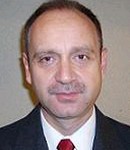
Plenary Lecture
Diagnosis of Complex Industrial Artificial Social Systems

Associate Professor Calin I. Ciufudean
Department of Computers, Automatics and Electronics
Faculty of Electrical Engineering and Computer Science
“Stefan Cel Mare” Universtity of Suceava
ROMANIA
E-mail: ciufudean.calin@gmail.com
Abstract: A manufacturing system includes a set of machines performing different operations, linked by a material handling system. A major consideration in designing a manufacturing system is its availability. When a machine or any other hardware component of the system fails, the system reconfiguration is often less than perfect. It is shown that, if these imperfections constitute even a very small percent of all possible system faults, the availability of the system may be considerably reduced. A state is operational when its performance is better than a threshold value. In order to calculate the availability of a manufacturing system, its states (each corresponding to an acceptable system level) are determined. A system level is acceptable when its production capacity is satisfied. To analyze the system with failure/repair processes, Petri nets and Markov models are often used. As a manufacturing system includes a large number of components with failure/repair processes, the system-level discrete event model becomes computationally intractable. Our approach for the analysis of manufacturing systems implies that the systems are decomposed in manufacturing cells. We focus on the diagnosis of the performance characteristics of workflows cells modelled with stochastic Petri net (SPN). This goal is achieved using a new model for Artificial Social Systems (ASOSs) behaviours, and by introducing equivalent transfer functions for SPN.
ASOSs exist in practically every multi-agent system, and play a major role in the performance and effectiveness chart of the agents. This is the reason why we introduce a suggestive model for ASOSs. To model complex systems, such as flexible manufacturing ones, a class of Petri nets is developed, and briefly introduced.
This allows representing the flow of physical resources and control information data of the ASOS’s components. In the analysis of SPN we use simulations in respect to timing parameters in a generalized semi-Markov process (GSMP). By using existing results on perturbation analysis (e.g., delays in supply with raw materials, equipment failure, etc.), and by extending them to new physical interpretations we address unbiased sensitivity estimators correlated with practical solutions in order to attenuate the perturbations.
The novelty of the approach is that the construction of large Markov chains is not required. Using a structural decomposition, the construction system is divided into cells. We can simplify the structure of the SPN using the presented approach, which is useful when we deal with complex Petri nets, and we need to simplify these structures (e.g. graphs) in order to analyze them properly. For each cell a Markov model was derived and the probability was determined of at least Ni working machines in cell i, for i = 1,2,..,n and j , where j=1, ..., m, working material handling system (MHS) at time t, where Ni and j satisfy the system production capacity requirements. Intuitively, bottleneck (BN) of a production line is understood as a machine that impedes the system performance in the strongest manner. Identification of BNs and their optimal capacity for avoiding the machines downtime is considered as one of the most important problems in manufacturing systems. Some examples illustrate this approach.
Brief Biography of the Speaker: • Academic Positions: Assoc. Professor Ph.D. Eng., Dept. of Automatics and Computers, Faculty of Electrical Engineering and Computer Science, “Stefan cel Mare” University of Suceava, Romania.
• Fields of Scientific Activities: Discrete Event Systems, Complex Measurement Systems, Reliability and Diagnosis of Control Systems, Environmental Management.
• He published 12 books and over 160 scientific papers in conference proceedings and journals.
• Honor Member of the Romanian Society of Electrical & Control Engineering - Member of the Romanian Technical Experts Corp.
• Technical Expert of the Romanian Ministry of Justice.
• President of the Romanian Society of Electrical & Control Engineering, Suceava Branch.
• He is a member of the editorial boards of several international scientific journals and conferences of control systems and electric engineering science. He was designated chairmen at 18 international conferences.